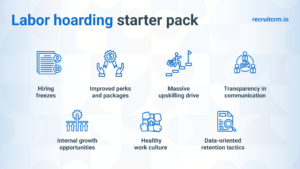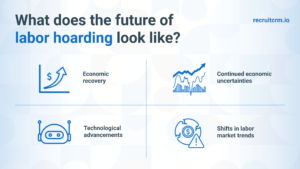A 2022 Skynova survey indicated that approximately 91% of small businesses were practicing labor hoarding, and around 89% intended to continue this trend into 2023.
Well, that’s a massive number, no doubt.
But what exactly is labor hoarding? Why is it a recruiting trend?
And the most important question here is – why do we have hard feelings for it?
Let’s find out.
What is labor hoarding & why is it practiced by recruiters?

Labor hoarding is a strategic business practice characterized by companies retaining a larger workforce than what is immediately necessary for their current level of production or service.
This approach is particularly prevalent during economic downturns or periods of market uncertainty, where future demand is unpredictable.
Industries like technology, healthcare, and manufacturing, where specific skills are in high demand, have shown higher tendencies towards labor hoarding.
Companies in these sectors are more likely to retain employees even during downturns to maintain their competitive edge and readiness for technological advancements and market demands.
By holding onto more employees than needed, companies aim to be well-prepared for a potential surge in business needs without the lag time associated with recruiting and training new staff.
Recruiters and businesses adopt labor hoarding for a variety of reasons:

1. Skill retention
In industries where specific skills are crucial, losing experienced workers can be detrimental.
Labor hoarding ensures that these valuable employees remain within the company, ready to contribute when business picks up.
This is especially important in sectors where rehiring and retraining would be costly and time-consuming.
2. Employee morale
Frequent layoffs and hiring can create a sense of instability within the workforce, leading to decreased morale and productivity.
By avoiding layoffs during slower business periods, companies can maintain a more motivated and engaged workforce.
3. Readiness for recovery
Economic downturns are often followed by periods of recovery and growth.
Companies practicing labor hoarding are better positioned to capitalize on this upswing, as they already have the workforce in place to handle increased demand.
Read more: 6 ways by which recruiters can combat an economic crisis
4. Corporate culture and reputation
Maintaining a stable workforce can enhance a company’s reputation as a reliable and employee-friendly place to work.
It can be beneficial for long-term branding and can make the company more attractive to potential future employees.
5. Government incentives or regulations
In some regions, government policies may incentivize companies to avoid layoffs.
These incentives can come in the form of tax breaks, subsidies, or compliance with labor laws that make layoffs less economically favorable.
6. Cost avoidance
The costs associated with layoffs, such as severance packages and the subsequent costs of rehiring and training new employees when the market recovers, can be substantial.
Labor hoarding can be a cost-effective strategy in the long run.
7. Market competition
In highly competitive markets, holding onto skilled employees can put you significantly ahead in line.
Companies may engage in labor hoarding to prevent competitors from acquiring their talented staff.
8. Project continuity
For businesses involved in long-term projects, retaining a consistent team can be crucial for maintaining continuity and quality of work.
Labor hoarding ensures that these projects are not disrupted by staff turnover.
9. Preservation of company culture
Labor hoarding can help maintain the established company culture, which can be disrupted by frequent staff turnover.
Additionally, it fosters stronger employee engagement and loyalty that can work in your favor in the long run.
What is the impact of labor hoarding on recruitment? Is it making hiring a nightmare?

Labor hoarding, when looked at superficially, sounds like a plan that can be executed.
But in practicality, the downsides of labor hoarding are often more significant than its advantages.
And as a conscious recruiter, it’s important to understand and interpret the possible challenges against the backdrop of your particular situation.
1. Shrinking talent pool
As companies retain more employees, the number of available and active job seekers in the job market can substantially decrease over time.
This leads to heightened competition among employers for the limited candidate pipeline of skilled workers, especially in sectors where specific expertise is in high demand.
2. Challenges in high-demand industries
Industries requiring specialized and sector-specific skills, such as technology, healthcare, and engineering, severely struggle due to practices like labor hoarding.
As a result, the talent gap between the demand for specific skills and the available talent supply widens, making it harder to fill roles that require unique or high-level competencies.
3. Stagnation of internal career opportunities
With fewer positions opening up during a recession, existing employees may find fewer opportunities for career advancement within their organizations, limiting their growth prospects.
In turn, this can lead to discontent among employees, potentially impacting their motivation and productivity.
4. Prolonged recruitment processes
The scarcity of suitable candidates can lead to longer recruitment cycles and extended hiring procedures as companies take more time to find the right fit.
Longer hiring processes can also inflate recruitment costs, including advertising, screening, and interviewing expenses.
5. Impact on new talent entry
Labor hoarding can often act as a barrier for new entrants. New graduates and individuals looking to enter the workforce or switch industries may find it particularly challenging to secure positions.
The situation here can lead to a mismatch in skill development, as new employees might not gain the experience needed to fill future skill gaps.
Read more: What are new graduates looking for? The ultimate guide to recruiting Gen Z
6. Quality of hire concerns
In desperate attempts to fill roles, some companies might compromise with their hiring standards, affecting the quality of new hires.
This can have long-term repercussions on team dynamics, productivity, and overall company performance.
7. Increased reliance on passive recruitment
Companies may increasingly target passive candidates (those not actively seeking a job) to fulfill their talent needs.
Such cases require different recruitment strategies, such as headhunting and networking, which can be more time-consuming and costly.
8. Rise in counteroffers and retention efforts
Faced with the prospect of losing valuable employees to competitors, companies may increase their retention efforts, including counteroffers.
This can lead to inflated salary expectations and a more competitive compensation landscape.
9. Reduced productivity
Employees may be underutilized during periods of low demand, leading to inefficiencies. It can lead to a major dip in their productivity and overall approach towards work.
Paying salaries to an underutilized workforce can strain the company’s finances heavily, making the situation even worse.
10. Stagnation of career opportunities
Labor hoarding plays a massive role in limiting the growth opportunities for employees, holding them back from taking on new challenges.
This can lead to employee frustration and demotivation among the ones seeking career progression.
11. Increased operational costs
The practice of labor hoarding is synonymous with higher wage bills – an absolute nightmare during a recession.
Retaining more employees than necessary can even create an irrecoverable dent in the company finances.
Similarly, incurring additional costs in terms of resources allocated to employees, such as workspace and equipment, are expenses that yield zero to no results.
12. Risk of skill obsolescence
Rapid technological advancements may render some skills obsolete, and labor hoarding can lead to a workforce that is not up-to-date with current trends.
Hence, adopting labor hoarding directly translates to ongoing investment in training and development to keep skills relevant.
13. Potential for organizational complacency
A stable workforce without new hires can lead to a severe lack of fresh perspectives and innovative ideas brought to the table.
On top of that, long-term employees may become resistant to change, impacting the company’s ability to adapt to new market conditions.
Labor hoarding vs. layoffs ft. an ongoing recession

Labor hoarding or Layoffs?
Economic downturns, like a recession, can create uncertainty in market demand.
In response, businesses adopt labor hoarding as a defensive strategy to ensure they have enough workforce to handle any sudden market recovery.
In such cases, the strategic choice between labor hoarding and layoffs is a critical one, deeply influencing a company’s trajectory and employee morale.
This decision is shaped by various factors, each carrying significant implications for the company’s immediate and long-term health:
Decision-making process
1. Financial health assessment
Labor hoarding:
Companies with a strong financial foundation may choose labor hoarding, viewing it as an investment in their workforce’s stability and future productivity.
This decision often stems from a calculated risk assessment, where the costs of retaining staff are balanced against the potential loss of skilled labor and the subsequent rehiring and training expenses.
Layoffs:
Firms facing immediate financial challenges, such as cash flow issues or significant revenue drops, might consider layoffs as a critical measure to reduce expenses quickly.
This decision is often driven by short-term financial survival needs, where maintaining the current workforce is deemed unsustainable.
2. Market recovery projections
Labor hoarding:
If a company anticipates a market recovery, it might opt to retain staff to ensure a quick and effective response to renewed demand.
This approach is based on the expectation that the market downturn is temporary and that maintaining a skilled workforce will provide a competitive edge when conditions improve.
Read more: Why top recruiters are embracing quiet hiring for a competitive edge
Layoffs:
In scenarios where the market outlook is uncertain or indicates a prolonged downturn, companies might resort to layoffs to resize their operations.
This decision is often a response to long-term market forecasts, aiming to align the workforce size with the expected business volume.
3. Skill set considerations
Labor hoarding:
In industries where specialized skills are crucial and talent is scarce, labor hoarding becomes a strategic tool to ensure that these critical skills remain within the company.
This approach is particularly relevant in sectors where the cost and time associated with training new employees are high, and the loss of experienced staff can significantly impact operations.
Layoffs:
More feasible in industries with a larger talent pool or where skills are more general.
In these cases, the assumption is that once the market recovers, it will be relatively easier and less costly to recruit and train new employees.
4. Cultural and ethical factors
Labor hoarding:
Reflects a commitment to employee welfare, fostering a culture of loyalty and stability.
It’s a decision that resonates with a company ethos that values long-term employee relationships and views staff as integral to the company’s success.
Layoffs:
Aligns with a culture that prioritizes operational flexibility and financial pragmatism (sensibility).
While it can raise ethical concerns about employee treatment, it’s often justified as a necessary step for the greater good of the company and its survival.
Short-term implications
1. Immediate financial impact
Labor hoarding:
While maintaining a full workforce incurs ongoing expenses, it avoids the costs associated with severance packages and potential legal challenges that layoffs might bring.
However, it can strain the company’s finances, especially if the downturn persists longer than anticipated.
Layoffs:
Offers immediate cost reductions, which can be crucial for cash-strapped companies.
However, it involves severance pay and potential legal fees and can impact unemployment insurance rates.
Additionally, there’s the often-overlooked cost of lost knowledge and skills, which can affect productivity and service quality.
2. Workforce morale and productivity
Labor hoarding:
Tends to maintain or even boost employee morale, as job security is assured.
This can lead to increased productivity, as employees feel valued and secure.
However, if not managed well, it can also lead to complacency or a false sense of security.
Layoffs:
Often results in a significant morale hit, not just for those who are laid off but also for the remaining employees who might experience survivor’s guilt or fear for their own job security.
This can lead to decreased productivity, engagement, and loyalty.
Long-term implications
1. Market recovery readiness
Labor hoarding:
Positions the company to quickly scale up operations when the market improves, without the lag of recruiting and training new staff.
This readiness can be a significant advantage in capturing market opportunities as they arise.
Layoffs:
While resizing the company for the current market, layoffs can leave the company understaffed and slow to respond to market recovery.
The process of recruiting, hiring, and training new employees can be time-consuming and costly, potentially causing missed opportunities.
Read more: Handling layoffs: How to recruit amidst this new crisis?
2. Talent management
Labor hoarding:
Preserves institutional knowledge and skilled labor, which is crucial for maintaining quality and efficiency.
It also reduces long-term recruitment and training costs, as the existing workforce is already aligned with the company’s processes and culture.
Layoffs:
This can lead to a significant loss of talent and institutional knowledge, making it more challenging to rebuild the workforce when conditions improve.
The process of attracting and training new employees can be more extensive and costly than anticipated.
3. Brand and reputation management
Labor hoarding:
Enhances the company’s reputation as a stable and responsible employer, which can be attractive to future talent and beneficial in customer perceptions.
This positive image can be a significant asset in future recruitment and business development efforts.
Layoffs:
It can negatively impact the company’s public image, affecting future hiring and, potentially, customer loyalty.
The perception of a company that frequently resorts to layoffs can be damaging to its employer brand.
4. Employee loyalty and engagement
Labor hoarding:
Fosters a sense of security among employees, leading to higher engagement and retention rates.
Employees are more likely to be loyal to a company that they perceive as having stood by them during tough times.
Layoffs:
Can create a culture of insecurity and uncertainty, reducing employee engagement and loyalty.
The remaining employees might start looking for more stable job opportunities, leading to a higher turnover rate.
5. Innovation and organizational growth
Labor hoarding:
Maintains a stable environment conducive to innovation, as employees feel secure and motivated to contribute new ideas and take risks.
This can be crucial for long-term growth and adaptation to market changes.
Layoffs:
It might hinder innovation and risk-taking as the focus shifts to job security and immediate tasks.
The reduced workforce might also lack the diversity of thought and experience necessary for innovative solutions.
How do recruiters tend to practice labor hoarding?

1. Implementing hiring freezes
Companies often put a temporary stop to new recruitment. This decision is usually made to maintain the current workforce size and avoid the costs associated with hiring new employees.
While this helps in retaining existing staff, it can also lead to workload challenges if the current workforce is not sufficient to handle increasing work demands.
Read more: What is a hiring freeze? A few smart things recruiters must do during one
2. Enhancing employee benefits
To retain their current employees, companies may offer attractive compensation packages, bonuses, or stock options.
This includes options like remote work, flexible hours, work-from-home policies, and overall other flexible work conditions.
Some perks might also include enhanced healthcare benefits, wellness programs, and other incentives that contribute to candidate satisfaction and loyalty.
3. Upskilling current employees
Investing in the professional development of existing employees ensures that they can take on a wider range of roles and responsibilities.
This approach not only prepares employees for different functions within the company but also contributes to their personal growth and job satisfaction.
4. Engaging in transparent communication
Engaging in open dialogues and keeping employees informed about the company’s plans, stability, and future prospects helps in building trust and a sense of security.
Recruiters tend to polish up their feedback mechanisms by encouraging a two-way communication channel.
Here, employees can voice their concerns and provide feedback, fostering a more inclusive and engaged workplace culture.
5. Creating internal mobility opportunities
Rather than hiring externally, companies focus on providing current employees with internal opportunities to move to different roles or departments within the organization.
It involves supporting employees in their career development and helping them understand their potential within the organization, thus increasing their engagement and reducing their likelihood of seeking out other opportunities.
6. Fostering a positive work environment
Building a strong, positive company culture that values and supports employees can be a key factor in retaining staff.
Promoting employee recognition and regularly acknowledging and rewarding employees’ contributions enhances their sense of belonging and appreciation.
7. Utilizing retention analytics
Using HR analytics to understand patterns in employee turnover and satisfaction allows companies to make informed, data-driven decisions about retention strategies.
This can help in identifying potential areas of concern through predictive modeling and addressing them proactively to prevent turnover.
What is the future of labor hoarding?

1. Economic recovery and stability
Post-recession adaptation: As the economy recovers from a recession, businesses may reassess their workforce strategies.
Workforce expansion: With economic stability, companies might feel more confident in expanding their workforce, potentially leading to a decline in labor hoarding practices.
2. Continued economic uncertainties
Persistent practice: If economic uncertainties and market fluctuations continue, businesses may choose to maintain their labor-hoarding strategies as a safeguard.
Industry-specific trends: This is particularly likely in industries where skilled labor is crucial and difficult to replace, such as technology, healthcare, and specialized manufacturing.
3. Technological advancements
Automation and AI: The increasing adoption of automation and AI could impact labor needs, potentially reducing the necessity for labor hoarding in some sectors.
Skill evolution: Conversely, new technologies might create a demand for new skills, reinforcing the need to retain and retrain existing employees.
Read more: Artificial intelligence in recruitment: How AI helps search firms streamline their hiring process
4. Changing workforce dynamics
Remote work and flexibility: The rise of remote work and flexible working arrangements could influence labor hoarding practices, as companies may find it easier to retain employees with these options.
Global talent pool: Access to a global talent pool through remote work could either reduce the need for labor hoarding or change its dynamics, as companies can tap into a wider range of skills and expertise.
5. Regulatory and policy changes
Government policies: Future labor market regulations and government incentives could either encourage or discourage labor hoarding practices.
International labor laws: Changes in international labor laws and trade agreements could also impact global companies’ labor strategies.
6. Shifts in labor market trends
Demographic changes: Aging populations in certain regions and changes in workforce demographics could influence labor hoarding trends.
Emerging skill sets: As new industries and skill sets emerge, companies might continue to hoard labor to ensure they have the necessary talent to stay competitive.
7. Sustainability and social responsibility
Corporate responsibility: Increasing focus on sustainability and corporate social responsibility might lead companies to prioritize stable employment practices, including labor hoarding.
Employee well-being: The emphasis on employee well-being and mental health could also play a role in how companies approach their workforce management strategies.
As we can tell throughout the article, labor hoarding acts as a buffer, providing businesses with a ready workforce to respond quickly to any positive shifts in market demand without the lag of scaling up their workforce from scratch.
Is it right for the economy? Not really.
Is it right for your business? You decide.
Frequently asked questions
1. How does labor hoarding affect a company’s competitiveness?
Labor hoarding can enhance a company’s competitiveness by ensuring it has a ready and skilled workforce when market conditions improve. This readiness allows for quick scaling of operations, maintaining a competitive edge over companies that may struggle with rehiring and training new staff.
2. Can labor hoarding be sustainable in the long term?
Labor hoarding can be sustainable if balanced with strategic workforce planning and financial management. Long-term sustainability depends on the company’s ability to absorb the costs and effectively utilize the retained workforce for innovation and growth as market conditions evolve.
3. How does labor hoarding impact new graduates entering the workforce?
Labor hoarding can limit opportunities for new graduates, as fewer positions are available for entry-level candidates. This can lead to challenges for graduates in finding relevant job openings, necessitating a focus on skill diversification and adaptability in their job search.
4. Are there specific industries where labor hoarding is more prevalent?
Labor hoarding is more prevalent in industries with specialized skills or where training and experience are crucial, such as technology, healthcare, and manufacturing. In these sectors, the cost and time involved in recruiting and training new staff are significant, making labor retention a priority.
5. How can companies balance labor hoarding with financial constraints?
Companies can balance labor hoarding with financial constraints by optimizing workforce productivity, exploring alternative revenue streams, and implementing cost-saving measures in non-essential areas. Strategic planning and regular financial reviews are key to maintaining this balance.




